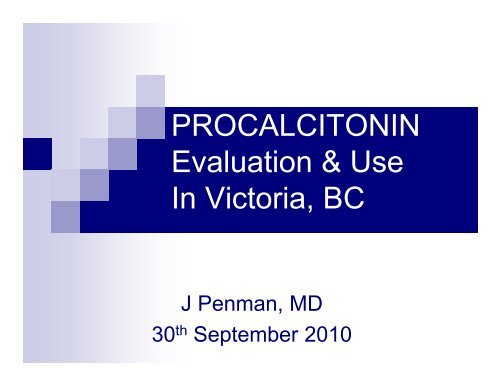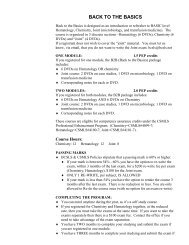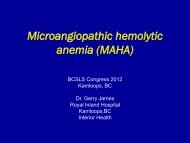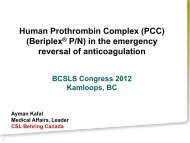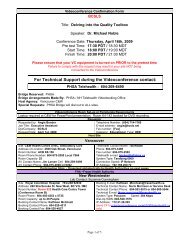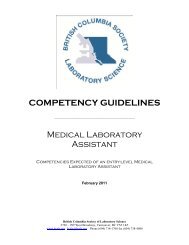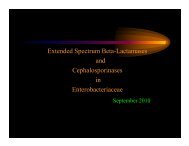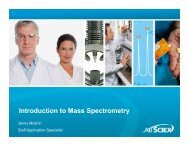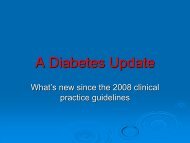PROCALCITONIN Evaluation & Use In Victoria, BC
PROCALCITONIN Evaluation & Use In Victoria, BC
PROCALCITONIN Evaluation & Use In Victoria, BC
You also want an ePaper? Increase the reach of your titles
YUMPU automatically turns print PDFs into web optimized ePapers that Google loves.
<strong>PROCALCITONIN</strong><br />
<strong>Evaluation</strong> & <strong>Use</strong><br />
<strong>In</strong> <strong>Victoria</strong>, <strong>BC</strong><br />
J Penman, MD<br />
30 th September 2010
CONTENTS<br />
SIRS, SEPSIS, PCT HISTORY & PHYSIOLOGY<br />
ASSAYS & INITIAL EVALUATION<br />
RESULTS OF PCT VERSUS CRP<br />
IMPLEMENTATION OF TESTING SERVICE<br />
LESSONS OF THE FIRST 6 MONTHS<br />
OTHER USES
SIRS & SEPSIS:<br />
SIRS Systemic <strong>In</strong>flammatory Reaction<br />
Syndrome, Characterized by >2 of following<br />
Fever or hypothermia >38 or 90 beats / min<br />
Tachypnea >20 breaths / min or PaCO2 >32 torr<br />
Leucocytosis or leucopenia >12 or
HISTORY OF PCT<br />
Originally investigated as a marker for<br />
medullary thyroid cancer in the 1970s<br />
Relationship to sepsis found in the 1990s<br />
Desired to distinguish Sepsis from SIRS<br />
Advent of 1st automated assay (Brahms)<br />
Other assays developed (Brahms patent)
PHYSIOLOGY-1<br />
PCT is the precursor molecule of Calcitonin<br />
Calcitonin only secreted by thyroid C-cells and acts<br />
to increase blood calcium.<br />
All body cells can transcribe the CALCA gene<br />
Main triggers are G-ve lipopolysaccharides (LPS),<br />
G+ve cell wall antigens & bacterial toxins that react<br />
with Toll-like Receptors (TLRs) on cell surfaces.<br />
These cells secrete Procalcitonin, not calcitonin
PCT STRUCTURE<br />
PRODUCT OF THE CALCITONIN RELATED POLYPEPTIDE<br />
ALPHA GENE (CALCA) ON CHROMOSOME 11 (p15.2)<br />
PCT OF THYROID C-CELLS 116 AA LONG<br />
PCT OF OTHER CELLS 114 AA LONG
THYROID C-CELL
OTHER BODY CELLS
PHYSIOLOGY-2<br />
Stimulated by bacterial Products on TLRs<br />
Part of innate immunity - uncertain function<br />
Reports of added PCT worsening inflammation<br />
Reports of removal of PCT decreasing inflammation<br />
<strong>In</strong>creased levels detectable within 6h<br />
Half life 30h<br />
Without stimulus, drops 30-50% within 24h<br />
Disposal – <strong>In</strong>ternal degradation, renal clearance<br />
is minor
PCT KINETICS
CONTENTS<br />
SIRS, SEPSIS, PCT HISTORY & PHYSIOLOGY<br />
ASSAYS & INITIAL EVALUATION<br />
RESULTS OF PCT VERSUS CRP<br />
IMPLEMENTATION OF TESTING SERVICE<br />
LESSONS OF THE FIRST 6 MONTHS<br />
OTHER USES
AUTOMATED ASSAYS<br />
Brahms Kryptor CL immunoassays<br />
All other assays under license from Brahms<br />
Calibrated against Brahms standards<br />
Licensed by Brahms; patent holder on PCT<br />
Roche ECL immunoassay<br />
BioMerieux Vidas CL immunoassay<br />
Siemens Centaur CL immunoassay<br />
Diasorin Liason CL immunoassay
INITIAL EVALUATION<br />
Objectives:<br />
Evaluate VIDAS & Roche assays<br />
Compare PCT to CRP (our prev.marker)<br />
Process:<br />
Collected 22 suspect sepsis + 2 without SIRS<br />
PCT (both assays) & CRP daily for 2-4 days<br />
Results compared to culture & clinical<br />
information from patients’ charts
COBAS ACCURACY<br />
Apparatus: Roche Cobas e601<br />
Analyte: <strong>PROCALCITONIN</strong><br />
Samples: PC PCT Level 1 & 2 (Roche QC)/VIDAS QC 1&2 Unit: ug/L<br />
Operator: Jennifer Annand Accuracy tolerance limit : 10.0%<br />
Level Sample Id Date Result 1 Result 2 Mean Result Assigned Deviation Accepted<br />
Mean (%)<br />
1 Vidas QC1 15-Jun-09 12.79 13.05 12.92 16.80 -23.1% NO<br />
2 Vidas QC2 15-Jun-09 1.40 1.43 1.42 1.79 -20.9% NO<br />
3<br />
4 PC PCT 1 15-Jun-09 0.494 0.486 0.49 0.48 2.1% YES<br />
5 PC PCT 2 15-Jun-09 9.80 9.88 9.84 9.69 1.5% YES<br />
Level Sample Id Date Result 1 Result 2 Mean Result Assigned<br />
Mean<br />
Deviation<br />
(%)<br />
Accepted<br />
1 Vidas QC1 16-Jun-09 12.85 12.88 12.87 16.80 -23.4% NO<br />
2 Vidas QC2 16-Jun-09 1.45 1.40 1.43 1.79 -20.4% NO<br />
3 FALSE<br />
4 PC PCT 1 16-Jun-09 0.477 0.485 0.48 0.48 0.2% YES<br />
5 PC PCT 2 16-Jun-09 9.71 9.82 9.77 9.69 0.8% YES
90<br />
80<br />
y = 0.8418x - 0.4055<br />
R² = 0.9949<br />
Roche e601 PCT (ug/L)<br />
70<br />
60<br />
50<br />
40<br />
30<br />
20<br />
10<br />
0<br />
0 10 20 30 40 50 60 70 80 90<br />
BioMerieux VIDAS PCT (ug/L)<br />
PCT Analytical-Systems Correlation between<br />
the Roche e601 and the BioMerieux VIDAS
ANALYZER SYSTEM METHOD MATRIX<br />
PCT<br />
ug/L<br />
Total<br />
Imprecision<br />
LLOQ<br />
ug/L<br />
BioMerieux VIDAS<br />
Chemiluminescence<br />
Monoclonal abs.<br />
Sandwich assay<br />
Vendor QC-1 15.28 2.91%<br />
BioMerieux VIDAS Vendor QC-2 1.76 3.56%<br />
0.09<br />
Roche Cobas e601<br />
Human Pl.-1 0.07 6.94%<br />
Electro-Chemi-<br />
Roche Cobas e601<br />
Luminescence<br />
Monoclonal abs.<br />
Human Pl.-2 4.86 1.35%<br />
Sandwich assay<br />
0.05-0.07<br />
Roche Cobas e601 Human Pl.-3 63.16 3.56%<br />
Table 1: Technology, precision and lower limit of quantitation of analyzer-systems
CONTENTS<br />
SIRS, SEPSIS, PCT HISTORY & PHYSIOLOGY<br />
ASSAYS & INITIAL EVALUATION<br />
RESULTS OF PCT VERSUS CRP<br />
IMPLEMENTATION OF TESTING SERVICE<br />
LESSONS OF THE FIRST 6 MONTHS<br />
OTHER USES
12.00<br />
LEGEND: VIDAS v CRP; ROCHE v CRP<br />
10.00<br />
8.00<br />
PCT (ug/L)<br />
6.00<br />
4.00<br />
y = 0.0148x + 0.7489<br />
R² = 0.1824<br />
y = 0.0148x + 0.1715<br />
R² = 0.2746<br />
2.00<br />
0.00<br />
0.00 50.00 100.00 150.00 200.00 250.00 300.00<br />
CRPs (mg/L)<br />
Correlation of PCTs with CRPs for PCT
INITIAL PCT AND CRP RESULTS<br />
CULTURE RESULTS (N)<br />
INTIAL PCT<br />
RANGE (MEDIAN)<br />
INITIAL CRP<br />
RANGE (MEDIAN)<br />
BLOOD CULT POS (7) 0.44->100 (63) 23-341 (87)<br />
OTHER CULT POS (7) 0.13-45 (5.0) 136-253 (207)<br />
CULTURE ND/NEG (10)
BLOOD CULTURE POSITIVE CASES<br />
<strong>In</strong> 5/7 cases the CRP results do not correlate with PCT nor with clinical status or changes<br />
CASES<br />
VIDAS<br />
CLIN CORREL<br />
VIDAS<br />
PCT<br />
CRPs<br />
ROCHE<br />
PCT<br />
ROCHE<br />
CLIN CORREL<br />
CULTURE RESULTS<br />
CLINICAL<br />
CORRELATION<br />
SEPSIS<br />
RANGES<br />
BACTERIAL<br />
INFECTION<br />
A<br />
C<br />
H<br />
I<br />
L<br />
O<br />
R<br />
1.25<br />
1.48<br />
1.01<br />
0.93<br />
>100<br />
>100<br />
>100<br />
50.08<br />
0.45<br />
0.60<br />
0.79<br />
82.28<br />
85.73<br />
59.47<br />
37<br />
39<br />
52<br />
45<br />
32<br />
159<br />
246<br />
195<br />
23<br />
44<br />
54<br />
258<br />
309<br />
327<br />
0.708<br />
0.864<br />
BL: MRSA<br />
BL: MRSA<br />
Improved with Rx<br />
SEPTIC SHOCK >100 PRESENT<br />
SHOCK LIKELY >50102100<br />
BL:E.col<br />
Recovered on Rx<br />
POSSIBLE >0.50100 UNLIKELY 0.25 - 0.50 LIKELY<br />
75.93 ABSENT 0.10 - 100<br />
>100<br />
341<br />
353<br />
87<br />
118<br />
62<br />
62.97<br />
28.47<br />
>100<br />
>100<br />
>100<br />
BL:Listeria<br />
CSF:Listeria<br />
SP/UR:NG<br />
BL: E.coli<br />
UR:NG<br />
BL:MRSA<br />
SPT:MRSA<br />
BL:E.coli<br />
BL:E.coli<br />
BL:MSSA<br />
Remained <strong>In</strong>fected. Antibiotic changed<br />
after these results<br />
Discharged 2 days<br />
after last result<br />
Improved clinically & on CXR over this time<br />
Improved. Oral Rx subsequent<br />
Died in septic shock
PCT v OTHER MKRS<br />
SOFA = Sequential Organ Failure Assessment<br />
Brahms’ data: www.procalcitonin.com
CONTENTS<br />
SIRS, SEPSIS, PCT HISTORY & PHYSIOLOGY<br />
ASSAYS & INITIAL EVALUATION<br />
RESULTS OF PCT VERSUS CRP<br />
IMPLEMENTATION OF TESTING SERVICE<br />
LESSONS OF THE FIRST 6 MONTHS<br />
OTHER USES
THE VALUE OF PCT<br />
Decision to treat with antibiotics:<br />
<br />
High negative predictive value (NPV) – ER Triage,<br />
Culture & treat / admit or discharge<br />
Wait 6-12h & repeat PCT / admit or discharge<br />
Monitoring Treatment<br />
<br />
PCT level tracks severity & progress – trend very useful<br />
Dropping 30-50% /d = successful Rx – continue<br />
Not dropping or increasing - change Rx, reculture<br />
Decision to stop antibiotics<br />
<br />
Unnecessary Rx is risky for patients and costly<br />
>90% drop from peak or
PCT & ABIOTIC Rx<br />
Brahms’ data: www.procalcitonin.com
OTHER POSSIBLE VALUE<br />
Monitoring patients at high risk<br />
Patients on immunosuppressive therapy<br />
Neonates born after PROM, maternal GpB Strep+ve<br />
Post Surgical & post trauma patients<br />
Reduce need for CRP or Lactate in Sepsis<br />
CRP and lactate are not sepsis specific<br />
Many orders are based on monitoring sepsis<br />
response to treatment which is better done with PCT<br />
TAT for PCT better than CRP – not POC like Lactate
PCT CAVEATS<br />
Not for guiding antibiotic treatment in :<br />
<strong>In</strong>fections: endocarditis, osteomyelitis,<br />
CNS infs, deep-infections, Pseudomonas<br />
pneumonia.<br />
Organisms: Listeria, Legionella, PCP,<br />
Mycobacteria<br />
Immunosuppressed patients
IMPLEMENTATION<br />
3 month evaluation in SI - ICUs & ERs<br />
Reference <strong>In</strong>terval Adults 0.25-0.50 – Bacterial infection likely – rpt 6-24h<br />
>0.50-2.0 – Bacterial infection very likely . Moderate risk<br />
for sepsis<br />
>2.0 – Bacterial infection very likely. High risk for sepsis
CONTENTS<br />
SIRS, SEPSIS, PCT HISTORY & PHYSIOLOGY<br />
ASSAYS & INITIAL EVALUATION<br />
RESULTS OF PCT VERSUS CRP<br />
IMPLEMENTATION OF TESTING SERVICE<br />
LESSONS OF THE FIRST 6 MONTHS<br />
OTHER USES
ACCEPTANCE OF TEST<br />
Generally good – some sceptics<br />
Not a silver bullet – better than CRP<br />
NPV and trend most useful of all<br />
Rapid uptake & sustained interest from<br />
ICU & ER<br />
<strong>In</strong>terest from NICU, Surgery & from upisland
ALGORITHM COMPLIANCE<br />
Criteria:<br />
Stop Rx & discharge sooner than Std of Care<br />
Order PCTs per algorithm<br />
Poor compliance with algorithm because:<br />
Decision levels too conservative (low)<br />
Algorithm & comments often conflict<br />
Cerner flags clear, comments not obvious
FALSE RESULTS<br />
False negatives not significant. High NPV<br />
False positives – i.e. not due to bact. inf.<br />
Ac.Pancreatitis, ext. burns, ext. lung damage<br />
Usually 80
NEXT STEPS<br />
Obtain an extension of clinical evaluation<br />
Revise the algorithm(s)<br />
Separate algorithms for ICU and ER<br />
Have regular case oriented discussions<br />
with users<br />
Evaluate the assay in other areas? NICU?
CONTENTS<br />
SIRS, SEPSIS, PCT HISTORY & PHYSIOLOGY<br />
ASSAYS & INITIAL EVALUATION<br />
RESULTS OF PCT VERSUS CRP<br />
IMPLEMENTATION OF TESTING SERVICE<br />
LESSONS OF THE FIRST 6 MONTHS<br />
OTHER USES
NEONATAL SEPSIS<br />
Wealth of literature claims that PCT has<br />
similar value in NICU as in adult ICU<br />
Added value to monitor susceptible<br />
neonates, e.g. low birth weight prems,<br />
PROM cases, maternal GBS+ve<br />
Reference intervals in first 24h a problem
PCT v HRS AFTER BIRTH<br />
Brahms’ data: www.procalcitonin.com
NEONATAL PROJECT<br />
<strong>In</strong>vestigate physiological increase in PCT<br />
Relation to delivery – C/S v Vaginal<br />
Relation to GIT colonization<br />
Look at LBWP infants (
OTHER USES FOR PCT<br />
Prediction of renal disease (5)<br />
parenchymal involvement in pediatric UTIs<br />
Long-term morbidity in pediatric UTIs<br />
<strong>In</strong> vesico-ureteric reflux<br />
Severity of acute pancreatitis (2)<br />
Diagnosis & monitoring of post Sx <strong>In</strong>fs. (9)<br />
As an indicator of survival in the ICU
THANK YOU
KEY REFERENCES<br />
1. Mirjam Christ-Crain et al: Effect of procalcitonin-guided treatment on<br />
antibiotic use and outcome in lower respiratory tract infections:<br />
cluster randomised, single-blinded intervention trial. Lancet; Feb 21,<br />
2004, 363:600-607<br />
2. Vandack Nobre et al: <strong>Use</strong> of Procalcitonin to Shorten Antibiotic<br />
Treatment Duration in Septic Patients. Am J Respir Crit Care Med; 2008,<br />
177:498-505<br />
3. Philipp Schuetz et al: Effect of Procalcitonin-Based Guidelines vs<br />
Standard Guidelines on Antibiotic <strong>Use</strong> in Lower Respiratory Tract<br />
<strong>In</strong>fections (ProHOSP). JAMA; Sep 9, 2009, 302(10):1059-1066<br />
4. Jamie N. Deis et al: Procalcitonin as a Marker of Severe Bacterial<br />
<strong>In</strong>fection in Children in the Emergency Department. Ped Emerg Care;<br />
Jan 2010, 26: 51-60


